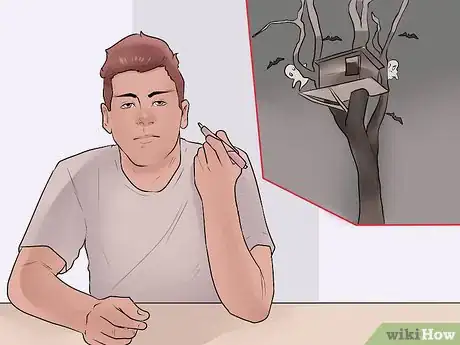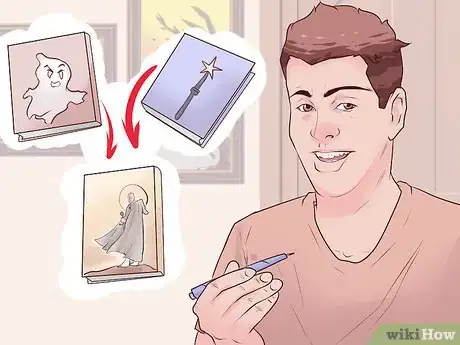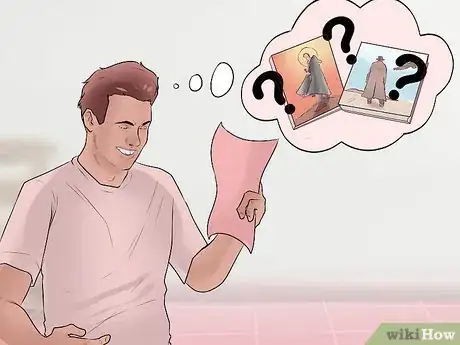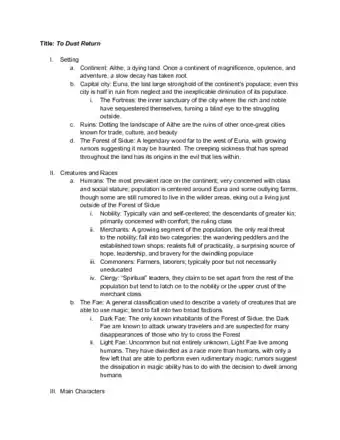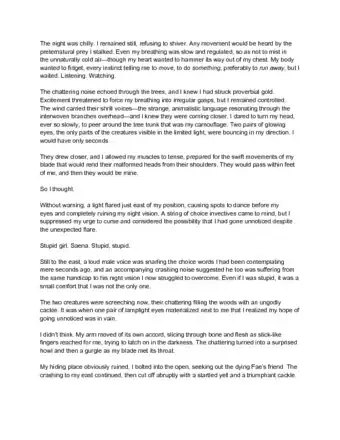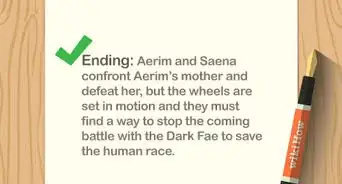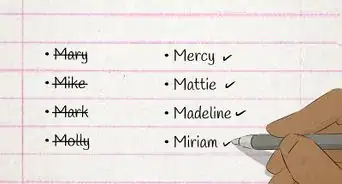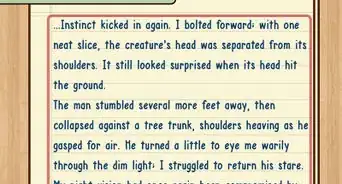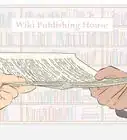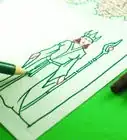This article was co-authored by Grant Faulkner, MA. Grant Faulkner is the Executive Director of National Novel Writing Month (NaNoWriMo) and the co-founder of 100 Word Story, a literary magazine. Grant has published two books on writing and has been published in The New York Times and Writer’s Digest. He co-hosts Write-minded, a weekly podcast on writing and publishing, and has a M.A. in Creative Writing from San Francisco State University.
This article has been viewed 76,086 times.
In dark fantasy stories, nothing is black and white. Heroes do morally questionable things, villains can have good intentions, and in the end it’s not always clear who is right and wrong. There’s also plenty of horror (think monsters, nefarious villains, evil gods, etc) as well as magic (spells, curses, rituals, and so on). If you want to write your own dark fantasy story but you’re not sure where to start, don’t worry! This wikiHow will walk you through everything you need to know, from world-building to character creation to plotting out great twists and turns.
Steps
Building the Story’s World
-
1Use elements of our world to create your own. One way to approach world building is to think about elements of our world that you can twist around or use as a jumping off point.[1] You may try reimagining your daily commute to work by flipping one element on its head, like a bus that is upside down or a commuter who is a goblin from another time period. Reality, or the real world, are good building blocks for creating a believable fantasy world.[2]
- You may also use elements of the world that you find disturbing or troubling and use them as the building blocks for your dark fantasy world. For example, maybe you dislike your office job and translate this dislike into a disturbing world where ghosts work office jobs. Or, maybe you want to examine abortion and use it as a jumping off point for a dark fantasy about a world where women are infertile and second class citizens in a totalitarian regime.
-
2Model your world on a historical time period or event. You may also use a certain historical time period or major historical event as inspiration for the world of your story. Leaning on history can help you to build off of reality and create a world where readers can see parallels with their own history.
- Maybe you are interested in the Civil War and end up creating a world where the Civil War failed, leading to consequences for characters in your world. Or, maybe you use the bombing of Hiroshima as a model for a catastrophic event that occurs in the world of your story, creating characters who have special abilities due to their exposure to radiation.
Advertisement -
3Turn an existing story or myth on its head. Many dark fantasy novels are “retellings” of myths, legends, and popular stories. These retellings are often done by twisting or turning certain elements of the existing story to make it new or strange. This approach can be useful for building a world that feels eerily familiar to a reader but also slightly off. Adding disturbing elements to an existing story can also present a different take on a familiar tale.
- For example, maybe you love Disney’s The Little Mermaid. You may then put your own take on the story, choosing a minor character in the tale and making them the main character, or reshaping the story so it is set in an underwater setting full of danger and horror that was not as present in the Disney version.
-
4Confine your world to a small area, like a house, a street, or a small town. Another option is to focus small and limit your world to a small area. This could be an enchanted house, a shape shifting street, or a town filled with misfits and supernatural beings. Sometimes, limiting the scope of your world can actually make it easier for you to focus on the small details and nuances of the setting.[3] You can also have characters who interact with each other often in a small space, leading to a higher potential for drama and conflict in the story.
- You may also have the setting act as another character in the story. For example, maybe your story is set in a mansion that has supernatural abilities and a mind of its own, creating danger and horror for the inhabitants of the mansion. Or, maybe the small town has a dark secret that they are trying to keep hidden, especially when a newcomer rolls into town asking questions.
-
5Consider the customs and traditions of the world. Once you have determined the world of the story or the setting, you should sit down and consider the details of the world. Think about the rules and customs of the world, as well as the traditions and habits of people who live in this world.[4] Consider if there is a governing body in the world and how they exert their authority over their people. These details will help you create a more believable, well rounded fantasy setting.[5]
- For example, your world may be run by aristocratic families who compete for territory, with customs that require lesser born people to follow these families. You may also have supernatural beings who exist in this world as second class citizens and outcasts, considered lesser than the aristocratic families who rule the people. This hierarchical structure of the world should come into play once your get characters into the setting.
- You may also have a dark fantasy world that resembles our world, except for a few strange habits and customs. For example, maybe instead of working in an office, people work in pods connected to a life force in the basement. Or, maybe instead of hopping on a bus, people hop on supernatural animals who act as taxis for humans.
-
6Create a language specific to the world. Another key detail of world building is to consider how people speak and communicate. Many dark fantasy worlds have characters who have their own language(s) and ways of communicating that may be different than our own. Considering this detail will allow you to create a richer and more complex fantasy world.[6]
- For example, you may decide to have some characters speak English, or your mother tongue, and some characters speak a fantastical language. You may then use an existing language, with a few changes, or create your own language that is only spoken by certain characters or beings.
Creating Your Characters
-
1Give your characters unique gifts or abilities. One of the joys of writing dark fantasy is that you are able to give your characters unique gifts or abilities. Having a main character who is unique or strange in some way will help to deepen her character and distinguish her from other characters in the story. Your main character may be the only one with these gifts or she may be surrounded by characters who also have gifts or abilities, but use them in different ways. Often, dark fantasy has characters with dark gifts that lead to trouble, conflict, and pain.
- For example, maybe your main character can communicate with the dead. This ability then leads her to communicate with the spirit of a dead Queen who pulls her into a fantastical world. Or, maybe your character is born half mutant, half human and must struggle to find her place in a world that views humans as lesser than or second class.
- You can also use your character's special abilities to create conflict and tension in the story, as she may be able to do things others cannot do or she may be ostracized for her abilities by others.
-
2Determine the physical and psychological traits of your characters. It may help you get a better sense of your characters by writing down their physical and psychological traits. This is known as a character profile, where you outline the basic details and traits of your characters in a list or chart form. You can then use the profile to help you better imagine how a character might act in a scene or respond to a conflict.[7]
- Your character profiles may include basic information on physical traits, such as height, weight, race, eye color, hair color, and any distinguishing features. You may also include psychological traits on your characters, such as their intelligence level, their educational background, their strengths and weaknesses, and their level of self confidence.[8]
- You can also use the physical and psychological traits of your characters to create conflict and tension in your story. Having distinguishing features may lead to the character being outcast or highly regarded in the world of your story. Using these features as a character trait and as an element in the plot of the story will allow you to cover two story essentials in one swoop.
-
3Create a quest or mission for your characters. Most dark fantasy novels are driven by a quest or mission, where your characters must face challenges and tests to achieve their goal. Though not every quest needs to be epic in scale or have global consequences, it does need to feel epic to your characters. Setting up a mission for your characters to fulfill will help your story to move forward with intensity and purpose, giving your readers motivation to read on.[9]
- You may set up an epic mission for your main character or characters, where they must return a sacred object to its rightful place in order to save the human race from extinction. Or, you may set up a more intimate mission for your characters, where they must help a ghost correct a mistake in the past so the ghost can move on. No matter the level of the mission, having a mission in your story will give your story stakes and a deeper sense of meaning.
-
4Make sure your characters have internal conflict and external conflict. Though most dark fantasy focuses on an external conflict, such as a mission, quest, or goal, good dark fantasy also focuses on internal conflict. They might be scarred by something in their past or fear to touch someone, maybe even have strong depression.Your characters should be motivated by internal issues they are dealing with as well as events happening in the world around them. Having this balance will help you create well-rounded, believable characters that your reader can empathize with.[10]
- For example, maybe your main character is a young girl who can commune with ghosts and is trying to help a dead queen fix a mistake in a past world. Her internal conflict may be that she does not know how to control her abilities and is afraid of not being able to make it back to her present world and her family in the present world. This internal conflict should then interact with her external conflict or ability to complete her mission.
Writing a First Draft
-
1Make a story outline. A story outline can be a useful way to get sense of the big picture of your story. You can also determine what the elements of your story are going to be, from the rising action to the climax to the story’s resolution. (Some people don't plan but get an idea and work over time.) And don't forget if you use either of the above you can leave it a later come back again to it.
- You may decide to use a plot diagram or the snowflake method to make an outline for your story. You may also try using both methods and see if different plot points emerge in your story when you compare and contrast both methods.
-
2Create a writing plan. To help get your story down on the page, you may create a writing plan that has a goal word count for each day. You may also place a time constraint on your writing plan, where you need to complete the first draft of the story by a certain date. Having a writing plan can help you stay motivated to write the story and get a draft done.[11]
- You may start by aiming for 500 words a day, with the goal of writing a 5,000 word draft of a dark fantasy short story within 10 days. Or, if you are writing a longer work, you may set word counts for the end of each week, with the goal of finishing a draft within several months to a year.
-
3Use sensory detail and description. When you are crafting your story, don’t forget to focus on sensory detail and description. This means considering how a character might experience a scene in terms of sight, sound, touch, taste, and smell. Using sensory detail will help the story come alive for the reader, especially if you are using fantastical elements. Describing the smell or sound of a fantastical object or detail will help it seem more real and easier to picture in the reader’s mind.
- As you write scenes in your story, think about how your narrator is experiencing a moment. What is she smelling, touching, tasting, hearing, and seeing as she walks around a space or watches characters in a scene? You should use descriptions that explores how it feels to be in the fantastical world, using your characters to access these details.
-
4Have your characters interact with the world of the story. Another key element of writing a dark fantasy story, or any story, is to ensure your characters are engaging with the story’s world. This means having your characters respond to elements of the world and comment on their feelings or thoughts about the fantastical world. Stay in the perspective of your characters and try to interact with the world through their point of view. This will help your characters and your fantastical world come alive.
- You may do this by having two characters engage in a dialogue where they discuss elements of the world and their own internal conflicts. Or, you may have a first person point of view that goes through her daily routine, allowing you to show readers how someone in the fantastical world gets ready to go to work or commutes to their job.
-
5Edit the story for clarity and detail. Read your draft out loud to yourself or to a sympathetic audience. Note any awkward sentences or unclear descriptions that you can edit and revise. Make sure the fantastical world reads as believable and engaging, packed with sensory detail. Mark down any scenes that feel underdeveloped or confusing.
- You should also ask for feedback on your draft from your sympathetic audience.[12] Ask them if they felt the details of the world were clear, and if they felt they understood the perspective of the main character. You may also ask if they have any suggestions on to make the story even more disturbing and unsettling. Pushing the horror element of your story could help it fit more into the genre of dark fantasy.
Understanding the Genre
-
1Learn the characteristics of dark fantasy as a genre. The dark fantasy genre is unique in that it seems to overlap with other genres, like fantasy and horror. Most works of dark fantasy focus on the frightening side of human nature, with elements of the sublime, the uncanny, and the weird. Unlike the traditional fantasy genre, the heroes of dark fantasy are often individuals who do unsavory or troubling things. This genre aims to entertain readers with psychological twists and turns.[13] [14]
- Like many sub genres, dark fantasy can be difficult to pin down. Some dark fantasy writers combine elements of horror with elements of fantasy to create a story set in an otherworldly place. Other dark fantasy writers apply psychological elements to a fantastical premise and create stories that are more about dystopia or the apocalypse.
- With the prominence of technology in the 21st century, many dark fantasy series are focusing on futuristic elements and modern dystopia. But there are also dark fantasy series that are about a fantastical world other than our own.
-
2Read examples of dark fantasy. To get a better sense of dark fantasy as a genre, you should take the time to read some good example texts.[15] Many dark fantasy stories are in the form of novels or a series of novels that focus on the same set of characters existing in the world of the story. For example:
- The Gunslinger by Stephen King.
- Perdido Street Station by China Miéville.
- The Book of the New Sun by Gene Wolfe.
- Sharp Ends by Joe Abercrombie.
- Coraline by Neil Gaiman.
- "Six of Crows" duology by Leigh Bardugo
-
3Analyze the examples. Once you read through one to two example texts, you should compare and contrast the author’s approach to the genre. You may notice similarities between the writing in the examples as well as other elements of dark fantasy, such as undertones of the sublime, the supernatural, and the weird. Ask yourself the following questions as you analyze the examples:
- Does the story focus more on psychological horror or bloody, gory horror? How does the story build suspense and engagement in the reader?
- How does the author build the world of the story? Does she use specific language and terms to describe the world? Does she or he use characters to illustrate how the world works?
- How do the characters in the story interact with the world? Do you root for one character in particular in the story? What types of bad decisions do the character(s) make in the story and how does this affect the outcome or ending of the story?
- Where there any dark moments in the story that disturbed or thrilled you? How does the author create these dark, disturbing moments without resorting to gore or graphic violence?
Sample Outline and Excerpt
Expert Q&A
-
QuestionHow do you create a new world for a dark fantasy novel?
 Grant Faulkner, MAGrant Faulkner is the Executive Director of National Novel Writing Month (NaNoWriMo) and the co-founder of 100 Word Story, a literary magazine. Grant has published two books on writing and has been published in The New York Times and Writer’s Digest. He co-hosts Write-minded, a weekly podcast on writing and publishing, and has a M.A. in Creative Writing from San Francisco State University.
Grant Faulkner, MAGrant Faulkner is the Executive Director of National Novel Writing Month (NaNoWriMo) and the co-founder of 100 Word Story, a literary magazine. Grant has published two books on writing and has been published in The New York Times and Writer’s Digest. He co-hosts Write-minded, a weekly podcast on writing and publishing, and has a M.A. in Creative Writing from San Francisco State University.
Professional Writer Treat that new world as a real world. Even if it might be full of different types of magic and fantasy, you still have to have your universe operate with certain physical rules in place. Every world has its own rules of gravity.
Treat that new world as a real world. Even if it might be full of different types of magic and fantasy, you still have to have your universe operate with certain physical rules in place. Every world has its own rules of gravity. -
QuestionHow can I differentiate between a fantasy and dark fantasy novel?
 Community AnswerDark fantasy is focused on dark myths and "creatures of the night" like vampires, werewolves and familiars. Fantasy is focused on fairytale creatures like fairies, unicorns and goblins. Of course, you can turn the normal fantasy into a dark fantasy by adding bloodthirsty elements and a touch of gothic.
Community AnswerDark fantasy is focused on dark myths and "creatures of the night" like vampires, werewolves and familiars. Fantasy is focused on fairytale creatures like fairies, unicorns and goblins. Of course, you can turn the normal fantasy into a dark fantasy by adding bloodthirsty elements and a touch of gothic.
References
- ↑ Grant Faulkner, MA. Professional Writer. Expert Interview. 8 January 2019.
- ↑ http://terribleminds.com/ramble/2012/06/19/25-things-you-should-know-about-writing-fantasyzzz/
- ↑ Grant Faulkner, MA. Professional Writer. Expert Interview. 8 January 2019.
- ↑ Grant Faulkner, MA. Professional Writer. Expert Interview. 8 January 2019.
- ↑ http://terribleminds.com/ramble/2012/06/19/25-things-you-should-know-about-writing-fantasyzzz/
- ↑ http://terribleminds.com/ramble/2012/06/19/25-things-you-should-know-about-writing-fantasyzzz/
- ↑ http://www.writerswrite.com/journal/jun98/how-to-create-a-character-profile-6986
- ↑ Grant Faulkner, MA. Professional Writer. Expert Interview. 8 January 2019.
- ↑ http://terribleminds.com/ramble/2012/06/19/25-things-you-should-know-about-writing-fantasyzzz/
- ↑ http://terribleminds.com/ramble/2012/06/19/25-things-you-should-know-about-writing-fantasyzzz/
- ↑ http://www.writersdigest.com/editor-blogs/there-are-no-rules/how-to-develop-a-writing-plan
- ↑ Grant Faulkner, MA. Professional Writer. Expert Interview. 8 January 2019.
- ↑ http://www.thecreativepenn.com/2009/07/19/dark-fantasy/
- ↑ https://colleenanderson.wordpress.com/2011/04/15/writing-what-is-dark-fantasy/
- ↑ Grant Faulkner, MA. Professional Writer. Expert Interview. 8 January 2019.




